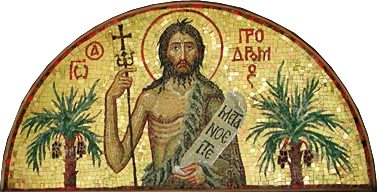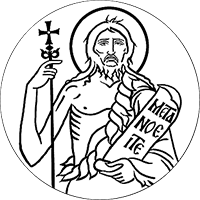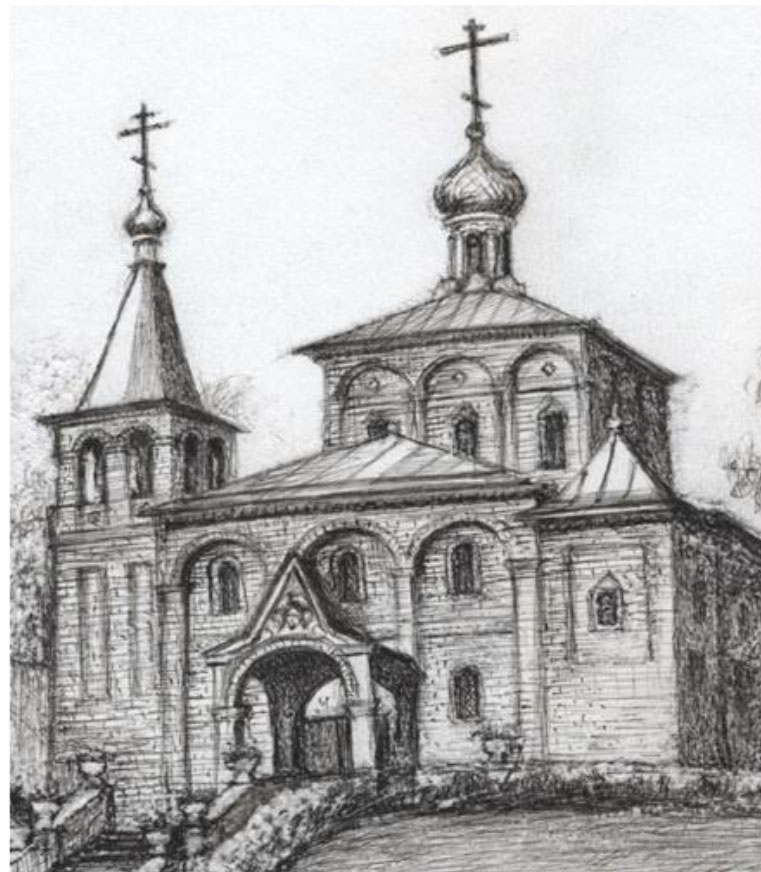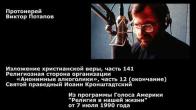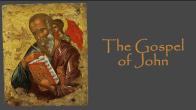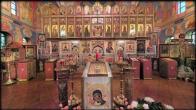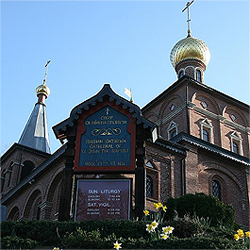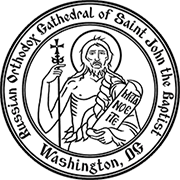You are here
THE KURSK-ROOT ICON OF THE MOTHER OF GOD
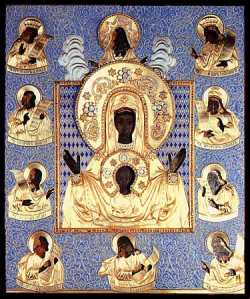
In the 13th century, during the dreadful period of the Tartar invasion of Russia, the devastated province of Kursk was emptied of people and its principal city, Kursk, became a wilderness. Now, the residents of the city of Rylsk, which had been preserved from invasion, often journeyed to the site of Kursk to hunt wild beasts. One of the hunters, going along the bank of the river Skal, which-was not very far from ruined Kursk, noticed an icon lying face down on the ground next to the root of a tree. The hunter picked it up and found that it was an icon of the Sign, such as was enshrined and venerated in the city of Novgorod. At this time, the icon's first miracle was worked, for no sooner had the hunter picked up the sacred image than there immediately gushed forth with great force an abundant spring of pure water. This took place on September 8th in the year 1295.
The hunter constructed a small wooden chapel and placed the newly manifested image of the Mother of God therein. The residents of Rylsk began to visit the place of the manifestation of this holy object and the icon was glorified by miracles all the more. Prince Vasily Shemyaka of Rylsk ordered that the icon be brought to the city of Rylsk itself and this was done in a solemn manner, for the people of the city went forth to met the icon of the Mother of God; but Shemyaka himself declined to attend the festivities and for this reason was punished with blindness. The prince, however, repented and straightway received healing. Moved by this miracle, Shemyaka constructed a church in the city of Rylsk in honor of the Nativity of the All-Holy Theotokos, and there the miraculous icon was enshrined on September 8th, the day of its manifestation, appointed as the annual feast date.
But the icon vanished in a miraculous manner and returned to the place of its original appearance. The residents of Rylsk continually brought it back, but each time it returned to its former place. Then, understanding that the Mother of God was well pleased to dwell in the place of the manifestation of her image, they eventually left it there in peace. Innumerable pilgrimages streamed to the site and services of supplication were celebrated there by a certain priest whose name was Bogoliub and who dwelt at the site of the wooden chapel and struggled there in asceticism.
In the year 1383, the province of Kursk was subjected to a new invasion of Tartars. They decided to set fire to the chapel, but it refused to burn, even though they piled up fuel all around it, and so the superstitious barbarians fell upon the priest Bogoliub, accusing him of sorcery. The pious priest denounced their foolishness and pointed out the icon of the Mother of God to them. The malicious Tartars laid hold of the holy icon and cut it in two, casting the pieces to either side. The chapeI then caught fire and the priest Bogoliub was carried off a prisoner.
In his captivity, the God-loving elder kept the Faith, placing his hope on the all-holy Mother of God, and his hope did not fail him. Now, one day as he was guarding flocks and passing the time by singing prayers and doxologies in honor of the Mother of God, there passed by some emissaries of the Tsar of Moscow.
They heard this chanting, arranged to ransom the priest from captivity, and Bogoliub returned to the former site of the chapel. There he found the pieces of the miraculous icon which the Tartars had cast away. He picked them up and straightway they grew together, although the signs of the split remained. Learning of this miracle, the residents of Rylsk gave glory to God and to His all-pure Mother. Again they attempted to transfer the holy icon to their city, but once more the miraculous image returned to its former place. A new chapel was then built on the original site of the icon's appearance and here it remained for about 200 years.
The city of Kursk was revived in the year 1597 at the command of Theodore Ivanovich of Moscow. This pious Tsar, who had heard of the miracles of the icon, expressed his desire to behold it, and in Moscow, the icon was greeted with great solemnity. The Tsaritsa, Irene Theodorovna, adorned the holy icon with a precious riza. At the command of the Tsar, the icon was set in a silver-gilt frame upon which were depicted the Lord of Hosts and prophets holding scrolls in their hands. The icon was subsequently returned and, with the close cooperation of the Tsar, a monastery was founded on the site of the chapel. A church, dedicated to the Life-bearing Spring, was built above the same spring that had appeared when the icon was first revealed and the monastery attached to it was called the Kursk Root Herrnitage in honor ofthe manifestation of the icon at the root of the tree.
During an invasion of Crimean Tartars, the icon was transferred to the cathedral church of Kursk, and an exact copy was left at the Hermitage. Tsar Boris Godunov bestowed many precious gifts for the adornment of the icon and even the pretender, the false Dimitry, who desired to call attention to himself and to win the support of those who lived in the vicinity of Kursk, venerated this icon and placed it in the royal mansions where it remained until the year 1615.
While the icon was absent from the city of Kursk, the grace-bearing aid of the Mother of God did not forsake that city, for when in the year 1612 the Poles laid siege to Kursk, certain of the citizens beheld the Mother of God and two radiant monks above the city. Captured Poles related that they, too, had beheld a woman and two radiant men on the city walls, and that this woman made threatening gestures at those who were conducting the siege. The citizens then made a vow to construct a monastery in honor of the all-holy Theotokos and to place the miraculous icon therein. The besiegers were quickly put to flight and in gratitude to their heavenly helper, the people of Kursk built a monastery in honor of the all-holy Theotokos of the Sign.
In 1676, the icon of the Mother of God of the Sign was borne to the Don River to bless the forces of the Don Cossacks. In 1684, a copy of the miraculous icon of the all-holy Theotokos of the Sign was sent to the Monastery of the Root by the sovereigns and great princes Ivan and Peter Alexievich. This copy was set in a silver-gilt frame and a command was made that this copy be borne wherever Orthodox warriors went into battle.
In the year 1812, the Kursk Civic Society sent to General Kutuzov a copy of the miraculous icon of Kursk, setting it in a silver-gilt frame. The commander expressed his gratitude to the citizens of Kursk and his belief that Kursk would remain free, thanks to the protection of the Queen of Heaven.
In March of 1898 a group of anarchists, desiring to undermine the faith of the people in the wonderworking power of the icon, decided to destroy it. They placed a time bomb in the Cathedral of the Sign, and at two o'clock in the morning a horrendous explosion rent the air and all the walls of the monastery were shaken. The frightened monastic brethren rushed immediately to the cathedral, where they beheld a scene of horrible devastation. The force of the blast had shattered the gilded canopy above the icon. The heavy marble base, constructed of several massive steps, had been jolted out of position and split into several pieces. A huge metal candlestick which stood before the icon and been blown to the opposite side of the cathedral. A door of cast iron located near the icon had been torn from its hinges and cast outside, where it smashed against a wall and caused a deep crack. All the windows in the cathedral and even those in the dome above were shattered. Amid the general devastation, the holy icon remained intact and even the glass within the frame remained whole. Thinking to destroy the icon, the anarchists had, on the contrary, become the cause of its greater glorification.
Every year on Friday of the ninth week after Pascha, the icon of the Sign was solemnly borne in procession from the Kursk Cathedral of the Sign to the place of its original manifestation at the Kursk Hermitage, where it remained until September 12. On September 13, it was again solemnly returned to the city of Kursk. This procession was instituted in the year 1618 in memory of the transfer of the icon from Moscow to Kursk and to commemorate its original appearance.
During the Bolshevik revolution, the icon was removed from the Cathedral of the Sign on April 12, 1918. Search was made for the icon but without result. The holy object was discovered under the following circumstances: Not far from the monastery there lived a poor girl and her mother who for three days had not had anything to eat. At that time Kursk was controlled by the Bolshevik regime. On May 3, the girl, a seamstress, went off to the marketplace in search of bread. Returning home at about one o'clock in the morning, she passed by a well which, according to tradition, had been dug by St. Theodosius of the Caves. There, on the edge of the well, she beheld a package wrapped in a sack, and when she opened it, in the package she found the sacred icon, which apparently had been left there by those who had stolen it.
At the end of October 1919, when the White Russian Army was evacuating the city of Kursk, twelve monks of the monastery transferred the icon to the city of Belgorod, from which it was again transferred, first to Taganrog and Ekaterinodar, and then to Novorossiisk. During the evacuation, with the permission of Metropolitan Anthony Khrapovitsky who was then President of the Higher Ecclesiastical Administration in Southern Russia, the icon was taken aboard the steamship St. Nicholas by Bishop Theophan of Kursk on March 1, 1920, and was transported to the city of Thessalonica. On April 3, Bishop Theophan took the icon to the city of Pec, the ancient capital of Serbia. For four months the icon remained in Pec, and in September, at the request of Baron Wrangel, it was returned again to the Crimea. A year after departing from the city of Kursk, on October 29, 1920, the holy image against left its native land during the evacuation of the White Army and those Russian people who refused to submit to the Soviet regime. After arriving again in the Kingdom of the Serbs, Croatians and Slovenes, with the blessing of Patriarch Dimitry, the holy icon remained with Bishop Theophan in the Serbian monastery of Yazak on Frushkaya Mountain. From the end of 1927, the icon was to be found in the Russian church of the Holy Trinity in the city of Belgrade.
With the blessing of the Synod of Bishops, Bishop Theophan bore the icon around to various places where Russians of the diaspora dwelt. During World War II, when Belgrade was subjected to bombardment and other tribulations associated with the war, the miraculous icon became a rampart of hope for all that approached it with sincere prayer.
The steadfast companion of those Russian people who did not accept the satanic authority, this great and ancient holy object, which remained in Moscow during the dreadful turmoil of the 17th century, was removed from Yugoslavia in the autumn of 1944 together with those who again fled the godless regime. From ruined Vienna, the icon was borne to the tranquil city of Carlsbad to which the Synod of Bishops had been evacuated. With the approach of the Bolsheviks it was again transferred to Munich in the spring of 1945. The holy icon proved to be an unending consolation to many thousands of people who were experiencing all the trials and tribulations of the latter years of World War II. From Munich the icon was borne to Switzerland, France, Belgium, England, Austria, and many cities and camps in Germany itself. Subsequently, the icon was transferred to the New World where it had its permanent residence first in the New Kursk Hermitage in Mahopac, N.Y., and then in the Synod's Cathedral Church of the Mother of God of the Sign in New York City, the residence of the First Hierarch of the Russian Orthodox Church Abroad. At present, by decree of the Council of Bishops of the Russian Orthodox Church Abroad, a festival is held in honor of the icon at the New Kursk Hermitage in Mahopac, N.Y., on the Sunday nearest the feast of the Nativity of the Most Holy Theotokos, and in the Synod's Cathedral of the Mother of God of the Sign in New York City on November 27/ December 10.
PARISH LIFE
RECENT VIDEOS
Address of our Cathedral
Subscribe to our mailing list
While all the materials on this site are copyrighted, you may use them freely as long as you treat them
with respect and provide attribution on the Russian Orthodox Cathedral of St.John the Baptist of Washington DC.
